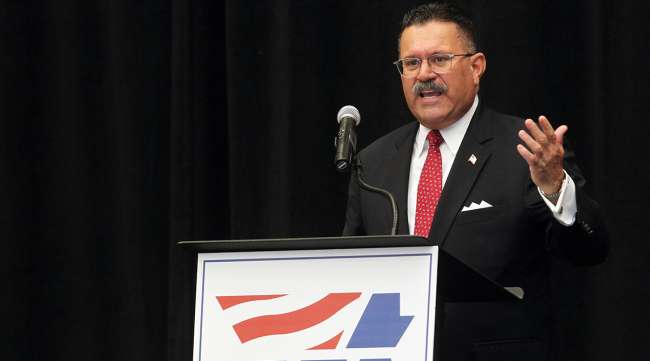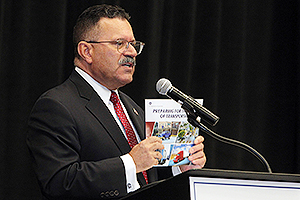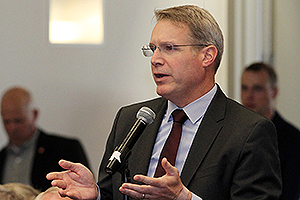Staff Reporter
FMCSA’s Ray Martinez Indicates Concern Over California’s Meal, Rest Break Rule

AUSTIN, Texas — As the Federal Motor Carrier Safety Administration prepares to evaluate comments related to California’s meal-and-rest-break requirements, its administrator expressed concern over the state’s rules, which differ from federal regulations.
Ray Martinez spoke at ATA’s Management Conference & Exhibition here Oct. 27.
California law requires employers to provide a “duty-free” 30-minute meal break for employees who work more than five hours a day, as well as a second duty-free, 30-minute meal break for those who work more than 10 hours a day.
American Trucking Associations petitioned FMCSA in late September to determine whether California’s meal-and-rest-break requirements are pre-empted under federal regulations.
With FMCSA’s period of public comment on California’s rules due to end Oct. 29, Martinez said the agency will reach a decision after assessing the comments. He cautioned against a system in which states maintain requirements that vary from federal regulations.
“I am very, very, very concerned about a patchwork system where every state gets to decide these issues,” Martinez said, receiving rousing applause from attendees. “That is not just an issue of commerce. That is an issue of safety. Everything we do is through the lens of safety and that’s how we will be evaluating this.”
During the speech, Martinez covered a swathe of trucking issues, ranging from hours-of-service rules and the driver shortage to autonomous technology and electronic logging devices.
The federal mandate requiring trucking firms to equip fleets with ELDs took effect in December 2017, two months before Martinez was confirmed to his post. The results of these devices, he said, show promise, citing a 48% decrease in HOS violations since the mandate took effect. He said that ELDs have given FMCSA the opportunity to re-examine the underlying issue of HOS rules, which have remained largely unchanged for trucking for 15 years.
Also, Martinez said young veterans trained to drive trucks can help redress the driver shortage, which ATA this year pegged at more than 50,000 people.
FMCSA is assessing the safety impacts of allowing qualified military personnel under age 21 to participate in interstate commerce. Martinez said that people between ages 18 and 21 who earn their commercial driver licenses as a way to earn a living are probably more serious drivers than others their age.

Martinez by John Sommers II for TT
He also encouraged drivers and industry executives to read AV 3.0, the agency’s policy update of autonomous vehicle technology guidelines that was unveiled Oct. 4. The update pertains to trucks, transit systems, cars and trains and highlights the need for safety and modernizing regulations.
Autonomous technology can take a variety of forms, from lane-departure warning systems and automated brakes to truck platooning. Some freight haulers have been apprehensive about autonomous vehicle technologies because they foster the perception that trucks soon may be driving themselves.
Martinez told attendees that autonomous vehicle technology necessitates a gradual implementation of ever-improving safety technology rather than a drastic shift in operations.
“Please read it. See what’s relevant to you,” Martinez said. “It is a forecast about where we’re going.”
FMCSA plans to continue to mold its framework and will later publish a fourth installment of the guidance.
Martinez spent more than 20 minutes fielding questions from the audience of trucking leaders.

Spear by John Sommers II for TT
ATA President Chris Spear asked about infrastructure legislation, citing the “thousands and thousands” of miles of roads and bridges deteriorating across the country.
Although Martinez pointed out that Congress’ lack of action on an infrastructure package hasn’t stopped FMCSA from issuing grants, he agreed with Spear and said he hopes such legislation can gain momentum after the Nov. 6 elections.
President Donald Trump’s infrastructure plan proposes $200 billion in federal funding that would couple with private investment to reach a $1.5 trillion.
FMCSA officials have demonstrated willingness to hear from truckers on their concerns, particularly with regard to HOS requirements. The agency has hosted several listening sessions over the past two months to discuss potential changes to the rules.
Martinez stressed the need for continued communication between the trucking industry and FMCSA, which he said can improve the lives of freight haulers, regulators and law enforcement officials alike.
“This is a two-way street,” Martinez said. “We want to make sure that we proceed in a manner that will give us the improved safety results that we seek.”


